Digs & Discoveries
Off the Grid
By MARLEY BROWN
Friday, June 10, 2022
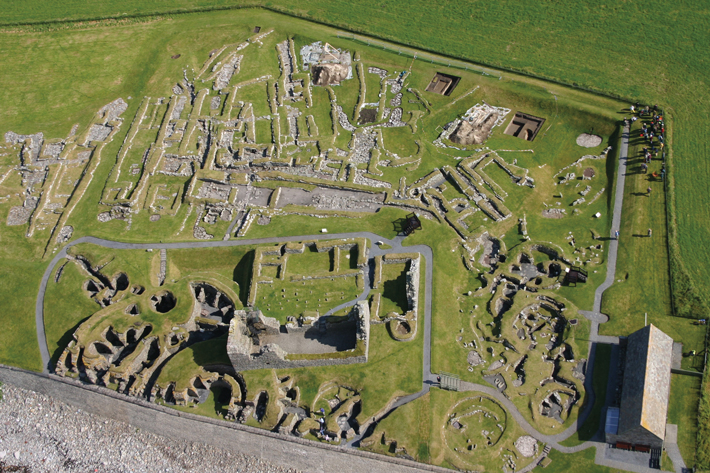
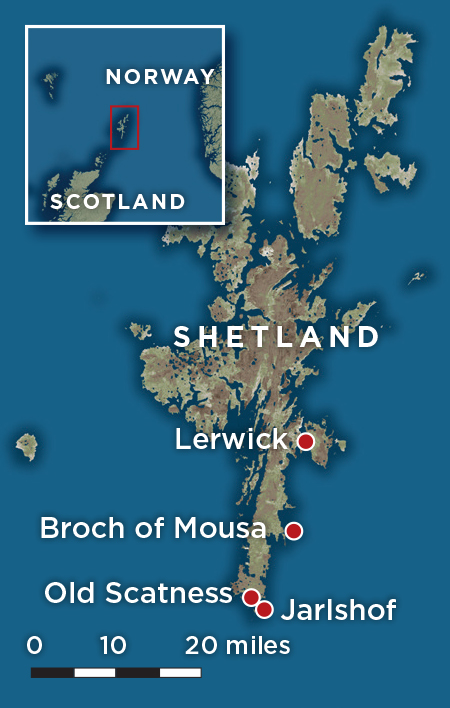 When the novelist Sir Walter Scott visited the southernmost tip of the Shetland Islands in 1814, he fell in love with the islands’ vivid sunsets, crashing waves, and growling puffins. There he encountered the ruins of a sixteenth-century Scottish laird’s house, which he named Jarlshof, combining Germanic words that mean “Earl’s House.” When he visited, Scott didn’t realize that the bright green turf surrounding Jarlshof hid the remains of ninth-century A.D. Norse longhouses and even older Iron Age, Bronze Age, and Neolithic settlements. In the 1890s, a series of storms revealed traces of these earlier periods of occupation, evidence that Jarlshof had been home to hearty farmers who, for thousands of years, had adapted to life on the unforgiving North Atlantic archipelago. Archaeologist Stephen Dockrill of the University of Bradford says that Jarlshof’s first inhabitants came to Shetland as early as 3600 B.C. and began cultivating grains and raising sheep and pigs. “We excavated middens that suggest a continuity of settlement over generations despite the area being particularly vulnerable to environmental impact,” says Dockrill. “Growing seasons are very short, and salt and sand from bad storms can ruin an entire year’s crop. But somehow people learned to manage the land.”
When the novelist Sir Walter Scott visited the southernmost tip of the Shetland Islands in 1814, he fell in love with the islands’ vivid sunsets, crashing waves, and growling puffins. There he encountered the ruins of a sixteenth-century Scottish laird’s house, which he named Jarlshof, combining Germanic words that mean “Earl’s House.” When he visited, Scott didn’t realize that the bright green turf surrounding Jarlshof hid the remains of ninth-century A.D. Norse longhouses and even older Iron Age, Bronze Age, and Neolithic settlements. In the 1890s, a series of storms revealed traces of these earlier periods of occupation, evidence that Jarlshof had been home to hearty farmers who, for thousands of years, had adapted to life on the unforgiving North Atlantic archipelago. Archaeologist Stephen Dockrill of the University of Bradford says that Jarlshof’s first inhabitants came to Shetland as early as 3600 B.C. and began cultivating grains and raising sheep and pigs. “We excavated middens that suggest a continuity of settlement over generations despite the area being particularly vulnerable to environmental impact,” says Dockrill. “Growing seasons are very short, and salt and sand from bad storms can ruin an entire year’s crop. But somehow people learned to manage the land.”
Archaeologist Julie Bond, also of the University of Bradford, says that throughout the Bronze Age and Iron Age, local people absorbed ideas from traders who came from across the British Isles. During the Iron Age, inhabitants began to build new types of structures, including sunken stone roundhouses called wheelhouses and round, tower-like structures called brochs. Researchers believe that ruling families lived in the lower levels of brochs, while the upper levels were used to store grain and other valuable resources. “People at Jarlshof remodeled older structures or built on top of them in order to avoid encroaching on planting fields,” says Bond. “In just one location, you can see how styles of architecture changed over the course of the centuries.” Viking settlers arrived in the ninth century A.D., introducing deep-sea fishing technology as well as the Norse language. Scotland annexed the Shetland Islands in the fifteenth century, and locals today, most of whom know only a few Norse words, celebrate the archipelago’s Scottish and Scandinavian heritage.
THE SITE
Start in the visitor’s center to learn about the history of Jarlshof and see artifacts uncovered during excavations at the site. Signs dotting the roughly five acres of grounds explain which stone structures date to the Neolithic period, the Bronze Age, the Iron Age, the Norse occupation, the medieval era, and the early modern period.
WHILE YOU’RE THERE
Take a boat tour from Shetland’s bustling hub of Lerwick to see the Broch of Mousa on the enchanting small island of Mousa. Thought to have been built around 100 B.C., it is the tallest broch still standing, rising to a height of 42 feet.
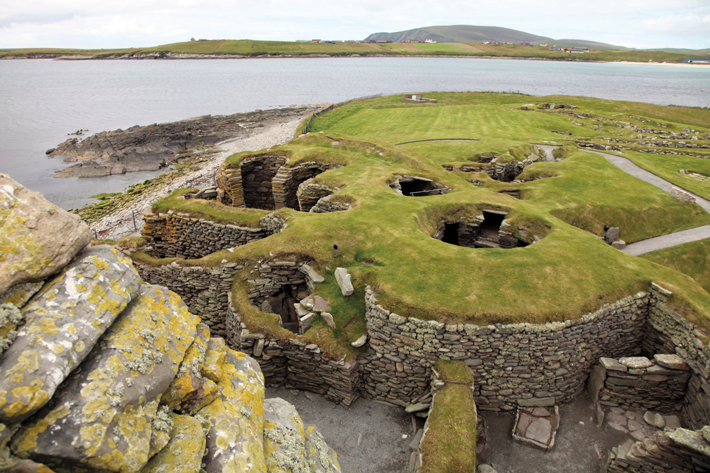
Made in China
By LING XIN
Friday, June 10, 2022
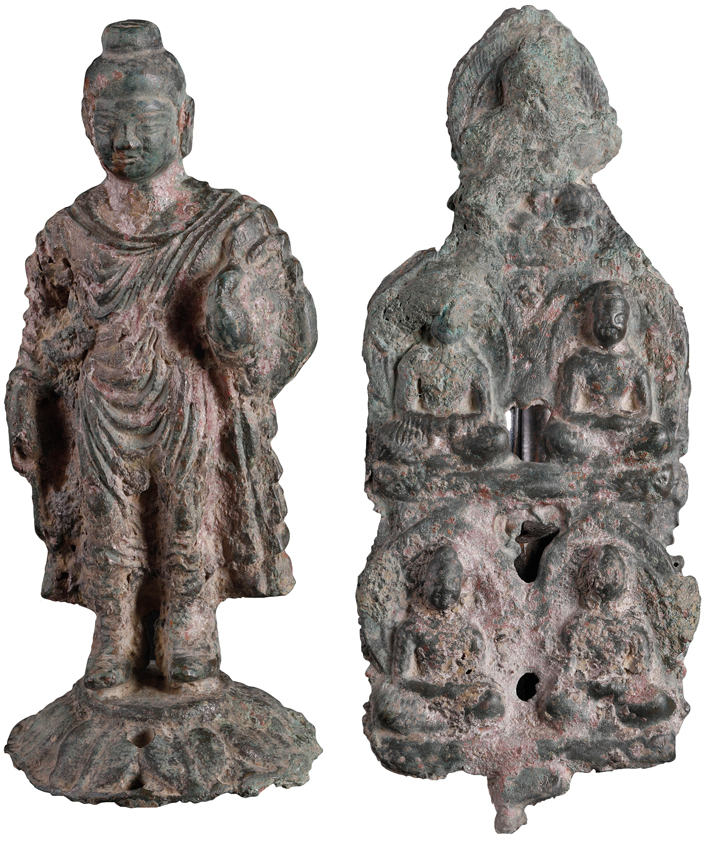 Statues of the Buddha unearthed in central China are leading to new interpretations of the early history of Buddhism in the country. While excavating a late Eastern Han Dynasty (A.D. 25–220) family tomb in Shaanxi Province, archaeologists discovered a four-inch-tall bronze figure of Gautama Buddha in a standing position and a six-inch figurine depicting five images of Buddha. Both statues are examples of the Greek-influenced Gandharan style of northwest Pakistan and eastern Afghanistan between the first and seventh centuries A.D.
Statues of the Buddha unearthed in central China are leading to new interpretations of the early history of Buddhism in the country. While excavating a late Eastern Han Dynasty (A.D. 25–220) family tomb in Shaanxi Province, archaeologists discovered a four-inch-tall bronze figure of Gautama Buddha in a standing position and a six-inch figurine depicting five images of Buddha. Both statues are examples of the Greek-influenced Gandharan style of northwest Pakistan and eastern Afghanistan between the first and seventh centuries A.D.
It is widely believed that Buddhism first reached China by means of Central Asia’s Silk Road during the reign of the emperor Han Ming (r. A.D. 57–75). However, prior to this discovery, the earliest known Buddha statues found in China had been dated to the Sixteen Kingdoms Period (A.D. 304–439), more than two centuries later. The recent find provides physical evidence of Buddhism’s early spread in China, says team leader Li Ming of the Shaanxi Academy of Archaeology. Analysis of the statues shows that they were made of an alloy of copper, tin, and lead, which is consistent with bronze-casting technologies in China in the first century A.D. Most contemporaneous Buddha figures from Central Asia were fashioned from an alloy of copper and zinc. Li believes it is much more likely that the statues were manufactured locally than that they were brought to China via the Silk Road.
The Maya Count Begins
By ZACH ZORICH
Friday, June 10, 2022
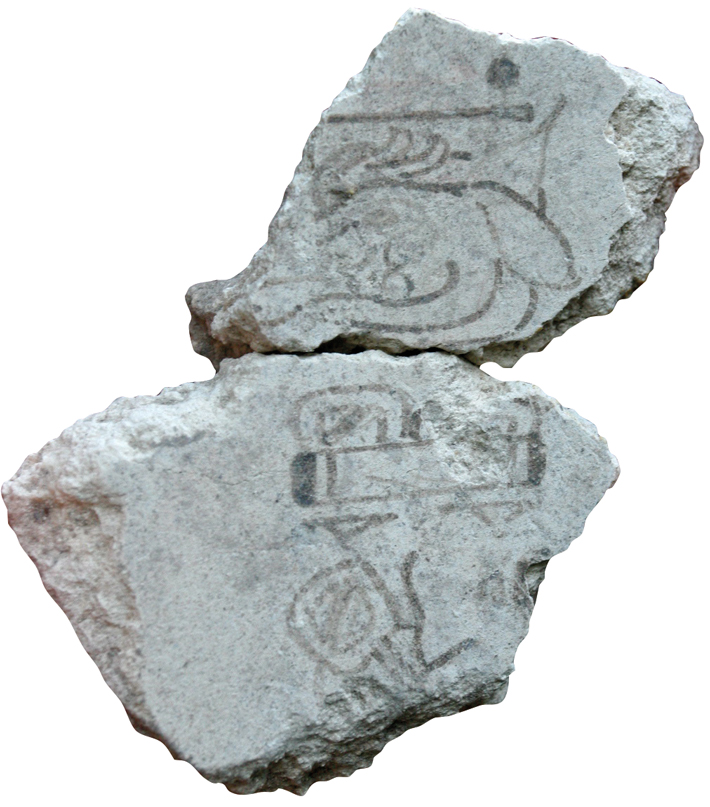 In the ancient Maya city of San Bartolo in Guatemala’s Petén rain forest, researchers have recovered pieces of a painting that include the earliest known date from the Maya ritual calendar. The painting was once featured on the wall of a chamber at the base of the city’s central pyramid. The chamber has been dated to 250 B.C. So far, 250 fragments of the painting have been found, of which 11 are inscribed with examples of early Maya writing. This writing is not yet translatable, with the exception of two fragments that include glyphs for the number 7 and the word “deer.” Seven Deer is a date in the 260-day-long Tzolk’in calendar, which is still used by modern-day Maya to determine when rituals should be performed. To archaeologist Heather Hurst of Skidmore College, the discovery has illuminated a profound connection between past and present. “I was in awe that across the rise and fall of dynasties,” she says, “across the Spanish invasion and the decimation of people that occurred, this calendar has been maintained, and the count has kept going.”
In the ancient Maya city of San Bartolo in Guatemala’s Petén rain forest, researchers have recovered pieces of a painting that include the earliest known date from the Maya ritual calendar. The painting was once featured on the wall of a chamber at the base of the city’s central pyramid. The chamber has been dated to 250 B.C. So far, 250 fragments of the painting have been found, of which 11 are inscribed with examples of early Maya writing. This writing is not yet translatable, with the exception of two fragments that include glyphs for the number 7 and the word “deer.” Seven Deer is a date in the 260-day-long Tzolk’in calendar, which is still used by modern-day Maya to determine when rituals should be performed. To archaeologist Heather Hurst of Skidmore College, the discovery has illuminated a profound connection between past and present. “I was in awe that across the rise and fall of dynasties,” she says, “across the Spanish invasion and the decimation of people that occurred, this calendar has been maintained, and the count has kept going.”
Hail to the Chief
By JARRETT A. LOBELL
Friday, June 10, 2022
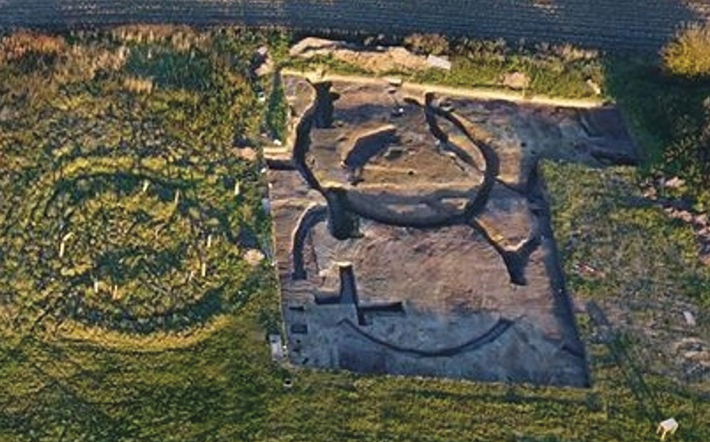 Northwest England is known for its rugged mountains, clear lakes, fields of daffodils, and four lads from Liverpool who changed the history of music. It’s less known for well-preserved archaeological sites, though not because they are absent. Unlike in the south, where large construction projects in recent decades have necessitated extensive archaeological investigations and where the chalky soil preserves materials well, much that remains of the past buried in the northwest’s acidic soil is hidden or lost. But recent excavations at the town of Poulton along the banks of the River Dee in Cheshire have begun to change scholars’ perceptions of this part of Britain, especially in the Iron Age. “Northwest England is thought of as an Iron Age backwater,” says archaeologist Kevin Cootes of Liverpool John Moores University. “But the time capsule of Iron Age life we have found is extraordinary.”
Northwest England is known for its rugged mountains, clear lakes, fields of daffodils, and four lads from Liverpool who changed the history of music. It’s less known for well-preserved archaeological sites, though not because they are absent. Unlike in the south, where large construction projects in recent decades have necessitated extensive archaeological investigations and where the chalky soil preserves materials well, much that remains of the past buried in the northwest’s acidic soil is hidden or lost. But recent excavations at the town of Poulton along the banks of the River Dee in Cheshire have begun to change scholars’ perceptions of this part of Britain, especially in the Iron Age. “Northwest England is thought of as an Iron Age backwater,” says archaeologist Kevin Cootes of Liverpool John Moores University. “But the time capsule of Iron Age life we have found is extraordinary.”
Thus far, Cootes has uncovered at least eight roundhouses, along with ditches filled with household debris dating from the eighth to first century B.C. His finds include more than 20 pounds of pottery vessels used for holding salt, more than 1,000 animal bones, and valuable items such as an iron adze, jet jewelry, bronze brooches, and worked deer antlers. In one of the houses, Cootes unearthed two dog burials—which he thinks may have been sacrifices—60 percent of the site’s animal bones, half of its pottery, and most of its metalwork. Based on these finds, Cootes suggests this may have been a chieftain’s house. “Rivers are the motorways of antiquity, and this is a high-status Iron Age riverside trading settlement,” he says. “We’re beginning to see that this is a vibrant area that is much more similar to high-status sites elsewhere than previously thought.”
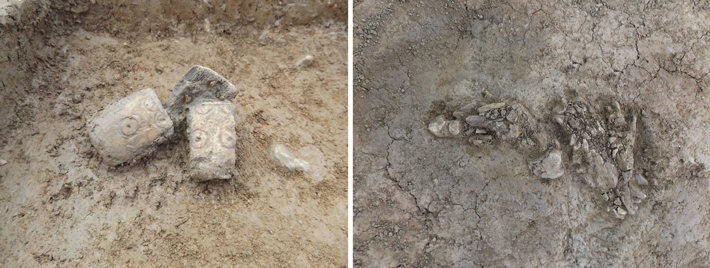
Speak, Memories
By ERIC A. POWELL
Friday, June 10, 2022
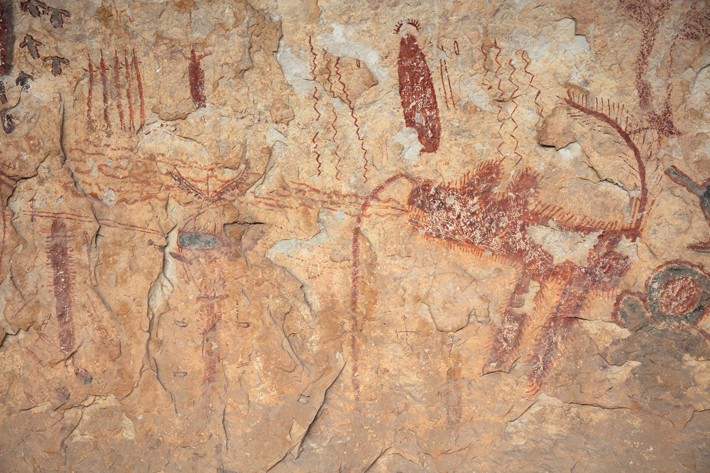 Artists have sought to depict sound in their work since at least the European Upper Paleolithic, some 36,000 years ago. A row of red dots emerging from the mouth of a lion in France’s Chauvet Cave, for instance, is one of the earliest known examples of an artist rendering an animal making a sound. Recently, Texas State University archaeologist Carolyn Boyd surveyed rock art made by hunter-gatherers living from around 2500 B.C. to A.D. 500 in the canyonlands of southwest Texas and the Mexican state of Coahuila to explore how these people may have depicted human and animal speech. She found that the artists, who worked in a tradition known as Pecos River Style rock art, used dots and lines made almost exclusively with red pigment to create what she calls “speech-breath” emanating from the mouths of close to 100 human and animal figures. Some Pecos River Style figures stand face-to-face exchanging emphatic red dots, as if they are debating or perhaps singing. Still other figures have delicate red lines coming from their mouths. “It’s almost as if they are whispering,” says Boyd. One half-human, half-feline figure bellows forth a series of energetic zigzag lines. “That seems to be a thunderous roar,” says Boyd. “For their creators, these weren’t just silent images, they were full of sound and life.” To see more images featuring Pecos River Style rock art speech-breath, click here.
Artists have sought to depict sound in their work since at least the European Upper Paleolithic, some 36,000 years ago. A row of red dots emerging from the mouth of a lion in France’s Chauvet Cave, for instance, is one of the earliest known examples of an artist rendering an animal making a sound. Recently, Texas State University archaeologist Carolyn Boyd surveyed rock art made by hunter-gatherers living from around 2500 B.C. to A.D. 500 in the canyonlands of southwest Texas and the Mexican state of Coahuila to explore how these people may have depicted human and animal speech. She found that the artists, who worked in a tradition known as Pecos River Style rock art, used dots and lines made almost exclusively with red pigment to create what she calls “speech-breath” emanating from the mouths of close to 100 human and animal figures. Some Pecos River Style figures stand face-to-face exchanging emphatic red dots, as if they are debating or perhaps singing. Still other figures have delicate red lines coming from their mouths. “It’s almost as if they are whispering,” says Boyd. One half-human, half-feline figure bellows forth a series of energetic zigzag lines. “That seems to be a thunderous roar,” says Boyd. “For their creators, these weren’t just silent images, they were full of sound and life.” To see more images featuring Pecos River Style rock art speech-breath, click here.
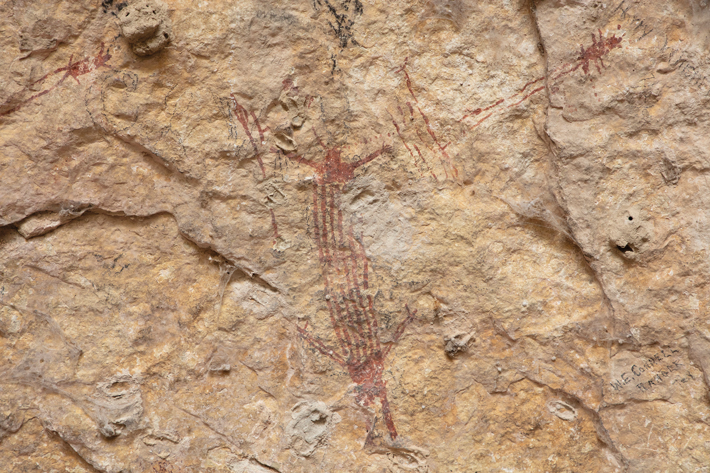
Advertisement
Advertisement
IN THIS ISSUE
Digs & Discoveries
Save the Dates
Spice Hunters
Suspicious Silver
A Civil War Bomb
The Great Maize Migration
Mummy Makers
Dignity of the Dead
Sailing in Sumer
Speak, Memories
The Maya Count Begins
Hail to the Chief
Made in China
Off the Grid
Around the World
Notre Dame’s dignitaries, Bronze Age daggers, the world’s biggest quake, a lost snowshoe, and 50,000-year-old Australians
Artifact
A portable connection
Advertisement

Recent Issues
-
 May/June 2024
May/June 2024
-
 March/April 2024
March/April 2024
-
 January/February 2024
January/February 2024
-
 November/December 2023
November/December 2023
-
 September/October 2023
September/October 2023
-
 July/August 2023
July/August 2023
-
 May/June 2023
May/June 2023
-
 March/April 2023
March/April 2023
-
 January/February 2023
January/February 2023
-
 November/December 2022
November/December 2022
-
 September/October 2022
September/October 2022
-
 July/August 2022
July/August 2022
-
 May/June 2022
May/June 2022
-
 March/April 2022
March/April 2022
-
 January/February 2022
January/February 2022
-
 November/December 2021
November/December 2021
-
 September/October 2021
September/October 2021
-
 July/August 2021
July/August 2021
-
 May/June 2021
May/June 2021
-
 March/April 2021
March/April 2021
-
 January/February 2021
January/February 2021
-
 November/December 2020
November/December 2020
-
 September/October 2020
September/October 2020
-
 July/August 2020
July/August 2020
-
 May/June 2020
May/June 2020
-
 March/April 2020
March/April 2020
-
 January/February 2020
January/February 2020
-
 November/December 2019
November/December 2019
-
 September/October 2019
September/October 2019
-
 July/August 2019
July/August 2019
-
 May/June 2019
May/June 2019
-
 March/April 2019
March/April 2019
-
 January/February 2019
January/February 2019
-
 November/December 2018
November/December 2018
-
 September/October 2018
September/October 2018
-
 July/August 2018
July/August 2018
-
 May/June 2018
May/June 2018
-
 March/April 2018
March/April 2018
-
 January/February 2018
January/February 2018
-
 November/December 2017
November/December 2017
-
 September/October 2017
September/October 2017
-
 July/August 2017
July/August 2017
-
 May/June 2017
May/June 2017
-
 March/April 2017
March/April 2017
-
 January/February 2017
January/February 2017
-
 November/December 2016
November/December 2016
-
 September/October 2016
September/October 2016
-
 July/August 2016
July/August 2016
-
 May/June 2016
May/June 2016
-
 March/April 2016
March/April 2016
-
 January/February 2016
January/February 2016
-
 November/December 2015
November/December 2015
-
 September/October 2015
September/October 2015
-
 July/August 2015
July/August 2015
-
 May/June 2015
May/June 2015
-
 March/April 2015
March/April 2015
-
 January/February 2015
January/February 2015
-
 November/December 2014
November/December 2014
-
 September/October 2014
September/October 2014
-
 July/August 2014
July/August 2014
-
 May/June 2014
May/June 2014
-
 March/April 2014
March/April 2014
-
 January/February 2014
January/February 2014
-
 November/December 2013
November/December 2013
-
 September/October 2013
September/October 2013
-
 July/August 2013
July/August 2013
-
 May/June 2013
May/June 2013
-
 March/April 2013
March/April 2013
-
 January/February 2013
January/February 2013
-
 November/December 2012
November/December 2012
-
 September/October 2012
September/October 2012
-
 July/August 2012
July/August 2012
-
 May/June 2012
May/June 2012
-
 March/April 2012
March/April 2012
-
 January/February 2012
January/February 2012
-
 November/December 2011
November/December 2011
-
 September/October 2011
September/October 2011
-
 July/August 2011
July/August 2011
-
 May/June 2011
May/June 2011
-
 March/April 2011
March/April 2011
-
 January/February 2011
January/February 2011
Advertisement






